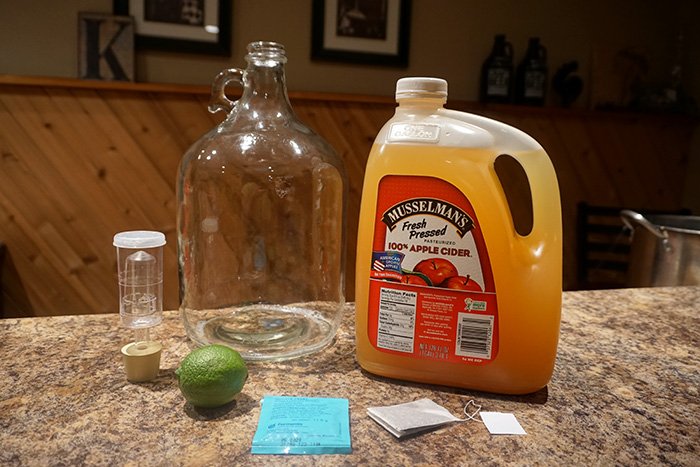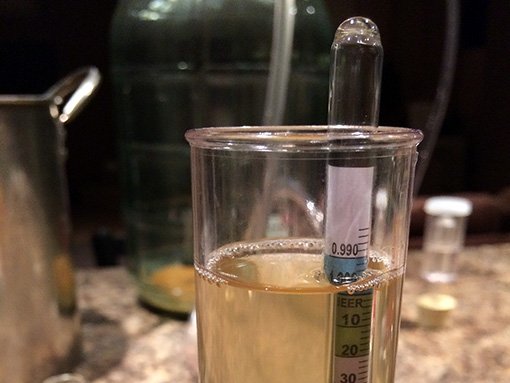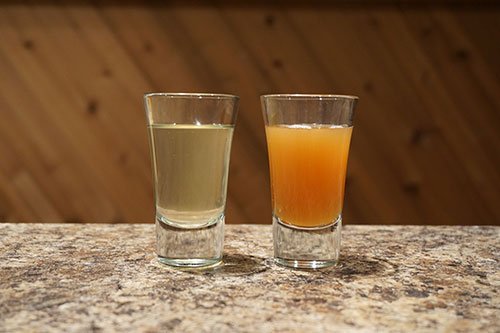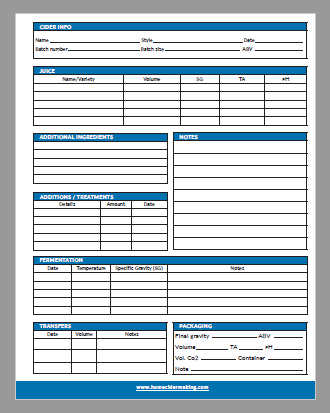Have you ever made a cider that tasted flat and watery that made you feel like you wasted a bunch of time waiting for your cider to mature? Or, maybe the cider is too acidic? I know I have and I tried to correct it by adding sugar or apple juice concentrate but just wasn’t able to nail the flavor I was looking for. Sound familiar?
Then I started playing acid adjustments and it has made major improvements and cut down on the amount of back sweetening needed!
I started using these techniques just in the last couple of months and I have already noticed major improvements in the quality of cider I have been making!
How do Acids Effect Cider?
Acidity plays a major role in the overall profile of good hard cider and can make or break the great flavor characteristics of the fruit. Besides flavor, acids also play a big role in fermentation and preservation of cider. If the pH of the cider is off, many undesirable things can happen such as bacterial infections and oxidation.
While pH and acidity are representative measurements of the acid in a cider, the measurements themselves are not interchangeable.
- pH is the measurement of the concentration of acid, or free hydrogen atoms, in the cider and tells exactly how strong or weak the solution is. pH is measured on a 1-14 scale with 3.0 to 4.5 being the range for cider. It’s also important to note that a liquid with a pH of 3.0 has ten times more acidity than one with a 4.0.
- Acidity, represented as TA or titratable acid, gives a measurement of the total amount of organic and inorganic acids in a solution but doesn’t necessarily indicate the strength of these acids. TA is expressed as grams per liter (g/L) or in a percentage of total volume with 1% acidity being equal to 10g/L.
Most apple juices have a pH of 3.0 for acidic juice and around 4.5 for a juice with weak acids according to Claude Jolicoeur’s article. Also, a finished hard cider is seen as microbially safe at pH 3.0 or lower while a pH of 3.0-3.8 may require sulfites (SO2) to stabilize and protect the cider. More on that later.
The typical TA of a hard cider depends on the style. European tannic ciders can be around 4.5 – 6.0 g/L while a North American semi-sweet to sweet sparkling cider may be in the range of 6.0 – 7.5 g/L or more where the sugar balances the higher acidity.
What Acids are in Cider?
That main acid present in apples is malic acid which can also be found in many fruits in various concentrations. Malic acid is the main contributor to the sourness in green apples and can impart a sharp flavor to a cider that can either be welcome or overpowering.
Apples also naturally contain several other acids such as tartaric and citric acid in various concentrations based on the variety of apples used.
Fresh pressed cider from an orchard containing a variety of apples may require some pre fermentation adjustments depending on how well the juice was blended.
Many store bought apple juices are specifically blended to be balanced, as you would expect from a commercial product so pre fermentation adjustments are rarely needed.
How to test the pH and TA of cider
Before you can make any adjustments to your cider, whether pre or post fermentation, you have to get an idea of the current acidity and pH. This can be done using some standard testing equipment that is readily available and affordable to the home cider maker.
To test the total acidity of cider you can use an acid testing kit to measure the titratable acids, or TA, in the cider. Most tests generally test for only one acid, tartaric, but generalizes the overall acid in the cider. Because the main acid in apples is malic, we need to make an adjustment for this.
Malic acid is weaker than tartaric, so the TA value that we discover using the sample kit will need to be multiplied by 0.89 to compensate for the difference and estimate the actual malic acid content of the juice.
To test the pH of cider, pH test strips or a digital pH meter can be used. Digital meters can be expensive and take must be calibrated but are more accurate and deliver a specific pH value while test strips rely on a color scale comparison. Both options work well but it comes down to preference and accuracy.
How to test the TA or acidity of hard cider?
I test the acidity of my cider using the Vinters Best Acid Testing Kit that I picked up at my local wine making shop. If you thought using a hydrometer took you back to chemistry class, this will definitely land you right back in the lab! Don’t worry though, it’s simple!
This kit includes:
Sodium Hydroxide
Phenolphthalein Indicator
Plastic Syringe
Testing Cup
- Pour 15cc of cider or juice into the test cup provided in the kit. Its best to pour off a sample from the fermenter into a secondary container before taking the sample so you do not contaminate the fermenter.
- Add three (3) drops of the phenolphthalein color solution to the sample of cider.
- Fill the plastic syringe with 10cc of the sodium hydroxide provided in the kit.
- Add the sodium hydroxide a few drops at a time to the cider or juice sample. As the sodium hydroxide is being added to the sample of cider, swirl the test cup until a slight color change is noted. Continue adding the sodium hydroxide one drop at a time while agitating the cup with each addition, until a deep, dark color change is noted and an additional drop does not affect color. This indicates the end point has been reached.
- Note the amount of sodium hydroxide left in the syringe when you’ve reached the end point. You’ll need to know how much was used (10cc minus what’s left in the syringe) to figure the result.
Each 1cc of sodium hydroxide required to achieve the color change indicates 0.1% of acid expressed as Tartaric Acid. For example, if 5 cc’s of sodium hydroxide is needed to attain the end point color change, then the acid level is 0.5%.
How to test the pH of cider
If testing acidity seemed difficult, don’t worry, taking a pH reading is really simple.
pH test strips such as Vinters Best, have a narrow range of 2.8-4.4 pH that is closer to where cider should be; making them more accurate. These test strips.and can simply be dipped into a sample and within seconds the strip will change colors. The color of the pH test strip can then be compared to the color scale associated with the strips to gauge pH. Some strips require the color to be viewed in natural sunlight so the colors can be accurately perceived.
A digital pH meter displays the actual pH value without the need to compare colors but the meter must be calibrated and cared for. Calibration of the pH meter can take some practice and afterwards the meter must be stored property to ensure future accuracy.
But, digital is really the way to go
How to adjust the pH of Hard Cider
The common adjustment is to lower the pH to reach a level that yeast can thrive in pre-fermentation or to preserves the cider post fermentation.
Methods to Lower pH
- Potassium Metabisulfite (SO2)
- Acid Additions
- Blending
- Cold Stabilization
- Water Additions
I won’t cover every method in this article but the most common is to use potassium metabisulfite (SO2) additions or acid additions.
Campden tablets, the most common form of SO2 for the home cider maker, come in various strengths measured in ppm.
When using acids to adjust the pH, it is important to keep in mind that there will be an effect on flavor. Most commonly, malic acid is used but weaker acids that provide different characteristics can be used.
How to adjust the TA of Hard Cider
Depending on where you are starting from and what type of cider you would like to make, you may need to make some acid adjustments. I like to use straight malic acid rather than the common acid blend that is used in winemaking because it is the main acid found in apples. Also, the blends don’t always say what percentage of each acid is in the container, so its harder to make calculated adjustments.
Using Malic Acid
Calculating the exact amount of acid needed requires a bunch of really complicated chemistry and each manufacturers product may be different. So, as a home cider maker, we will generalize on accepted values rather than spend a ton of time writing equations.
1.0 g/L addition of Malic acid will increase the TA by about 1.12 g/L and will decrease the pH by 0.08 pH units.
Add 8.9g of malic acid to 100ml of water
Adding 1ml of this solution to your sample will result in a TA increase of 0.100g per 100ml
Sampling Process
When making acid adjustments, I like to get a baseline by testing the TA and then making several 100ml samples with various concentrations similar to making tannin additions.
Once I know that I am in the ballpark, I use my sense of taste to dial exactly how much malic acid to add to my cider by calculating the total addition.
Example:
Sample Size: 100ml
Acid Solution: 8.9g/100ml
Addition: 5ml
Batch Size: 5 gallons
5ml of the solution would be 5% of the 8.9g of malic acid or 0.445g per 100ml or 4.45g/L
5 gallons equals 18.9721 liters
18.9721L x 4.45g =
84.42 g Malic Acid
Is Acidity or pH More Important?
pH is important for preserving cider in the long term especially when planning to age for periods of time over one year. Protecting the flavor you have is probably better than trying to adjust purely on taste that could be damaged by a high pH later.
That being said, its all about balance and experience. These adjustments will take some practice and experimenting but in the end, I guarantee it will be worth it!




Curt, greetings. I am beginning batch of 100 litres of cider with Orchard apple juice, I put in 25 Campden tablets to rid the must of wild bacteria…waited 2 days, yet on the second day its errupting in foam. Should I wait till it settles down before adding dry yeast? The beginning OG was 1.048 which I thought was normal. The temp is 70. Any suggestions?
Your final calculation in your blog says 5 gals= 18.9721.
Then in the formula it uses 19.9721.
Is it a typo or am I missing something?
Hi Benny, that was a typo, but the final number was correct. Thanks for catching that!
So what should the target pH be?
The target PH should be 3,3 -3,7
I´d say that somewhere between 3.1 and 3.5
And what would be the ideal TA be please? Mine is at .56
Where do I find Malic Acid?
I would think a simple google search would find you some in your area. I got mine on Amazon.
Hi, thanks for the article, I have 4 batches that have been through fermentation and I’ve racked them off recently, each batch is from a different variety. Two of them are at a pH of 3.1 and taste quite acidy. I think I might’ve misread your instructions and I’ve added Camden tablets which looks like it will lower the pH and make it more acidy. How can I increase the pH, to be less acidy?